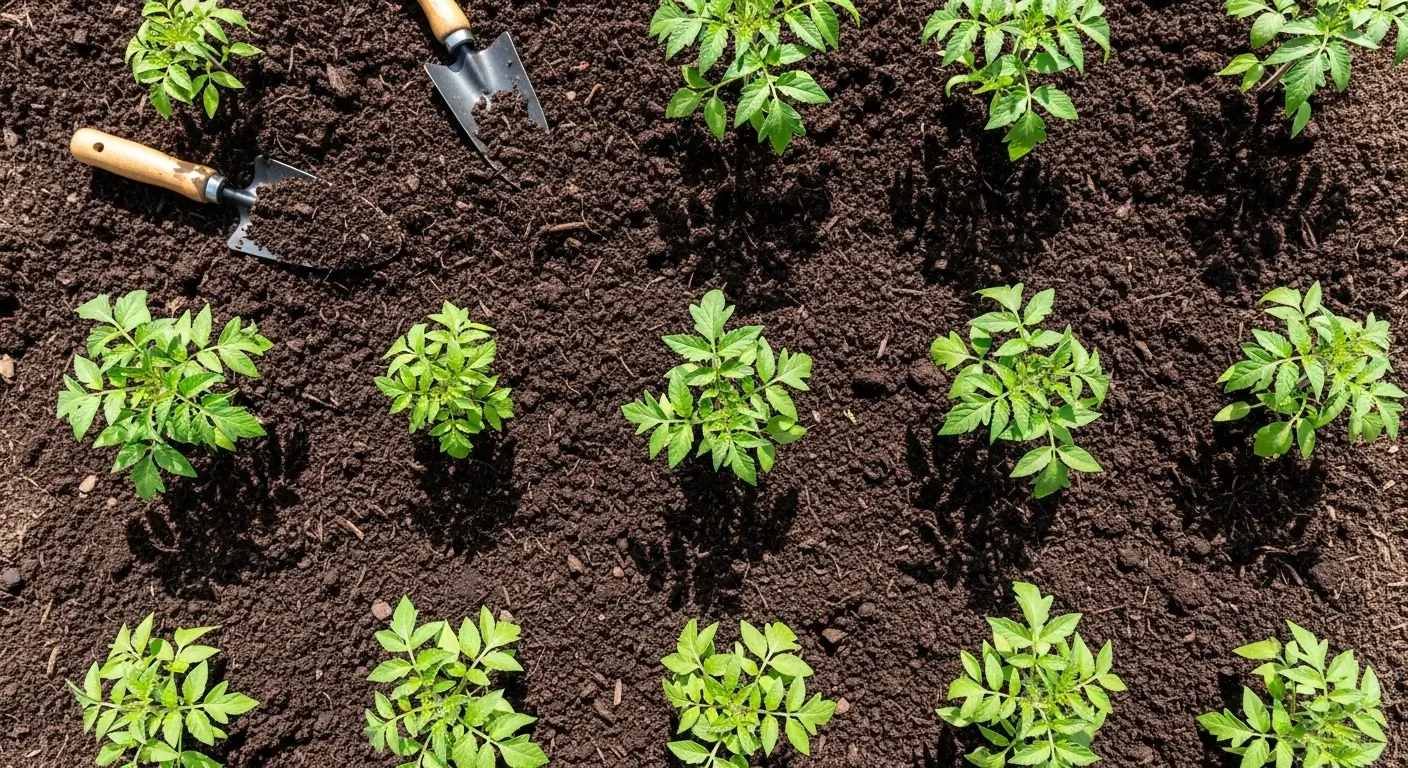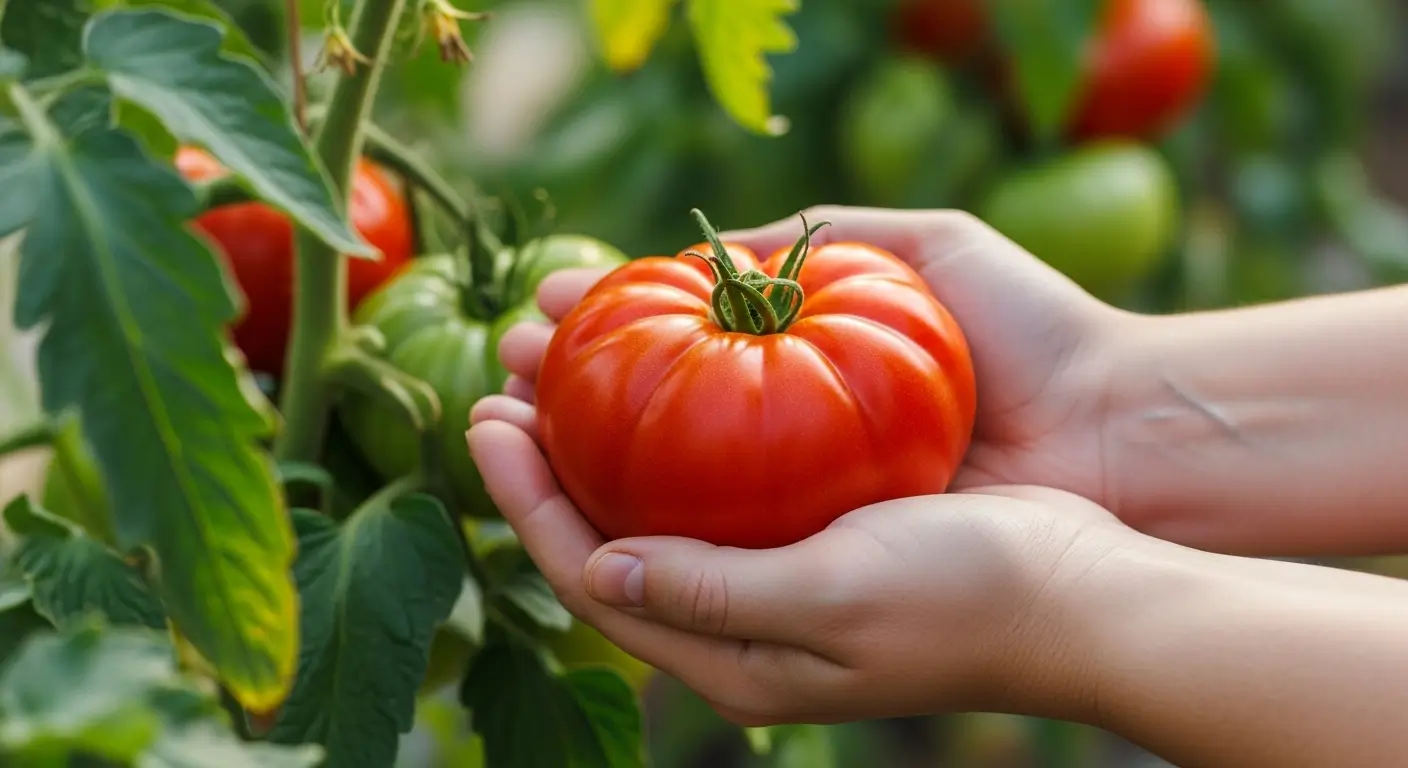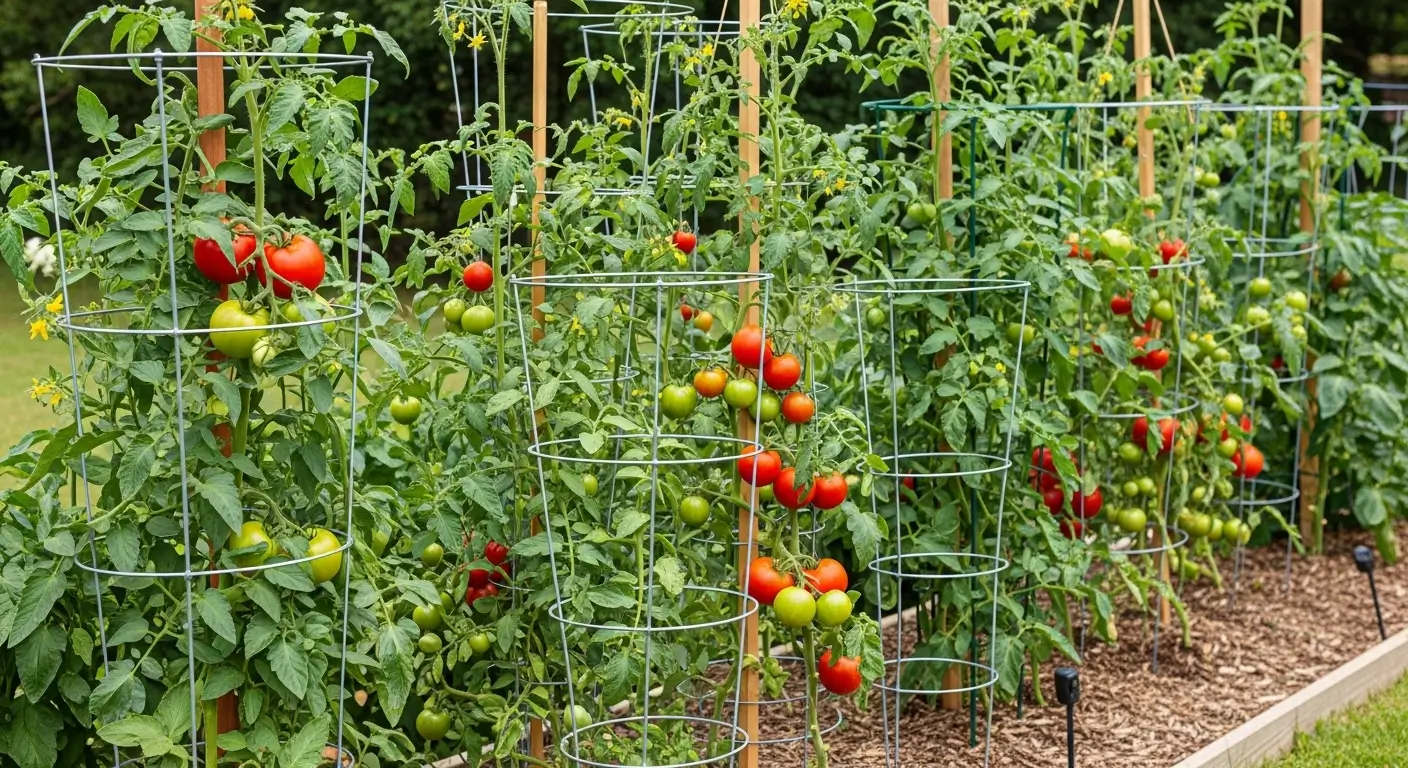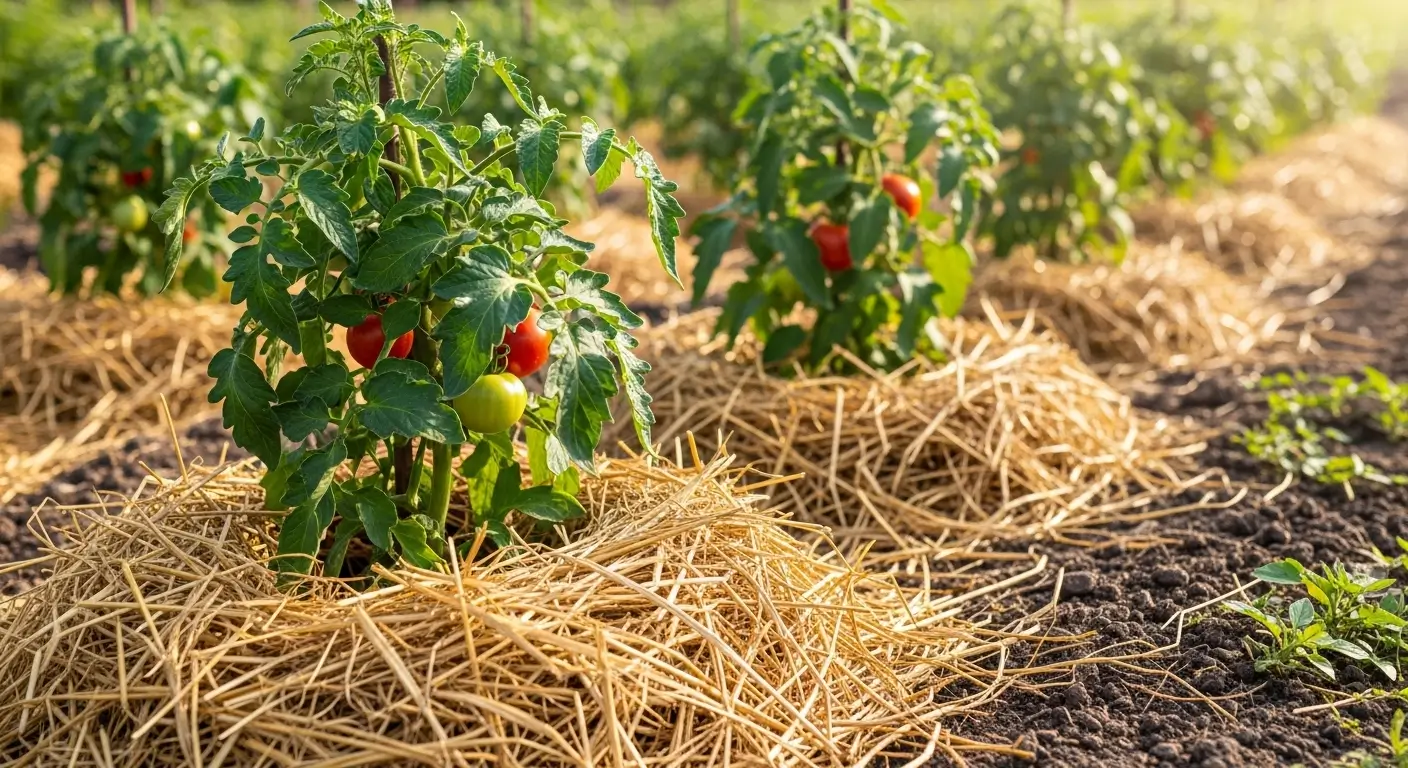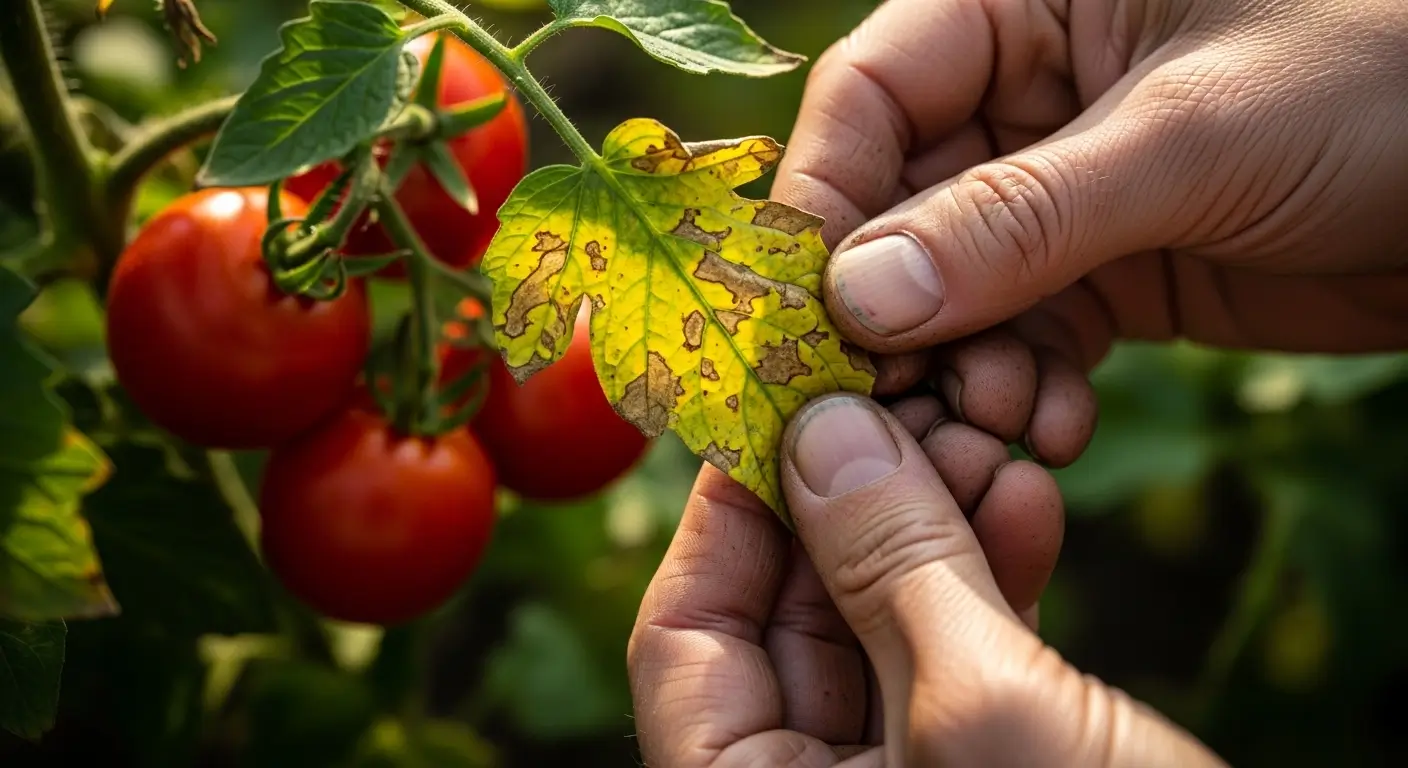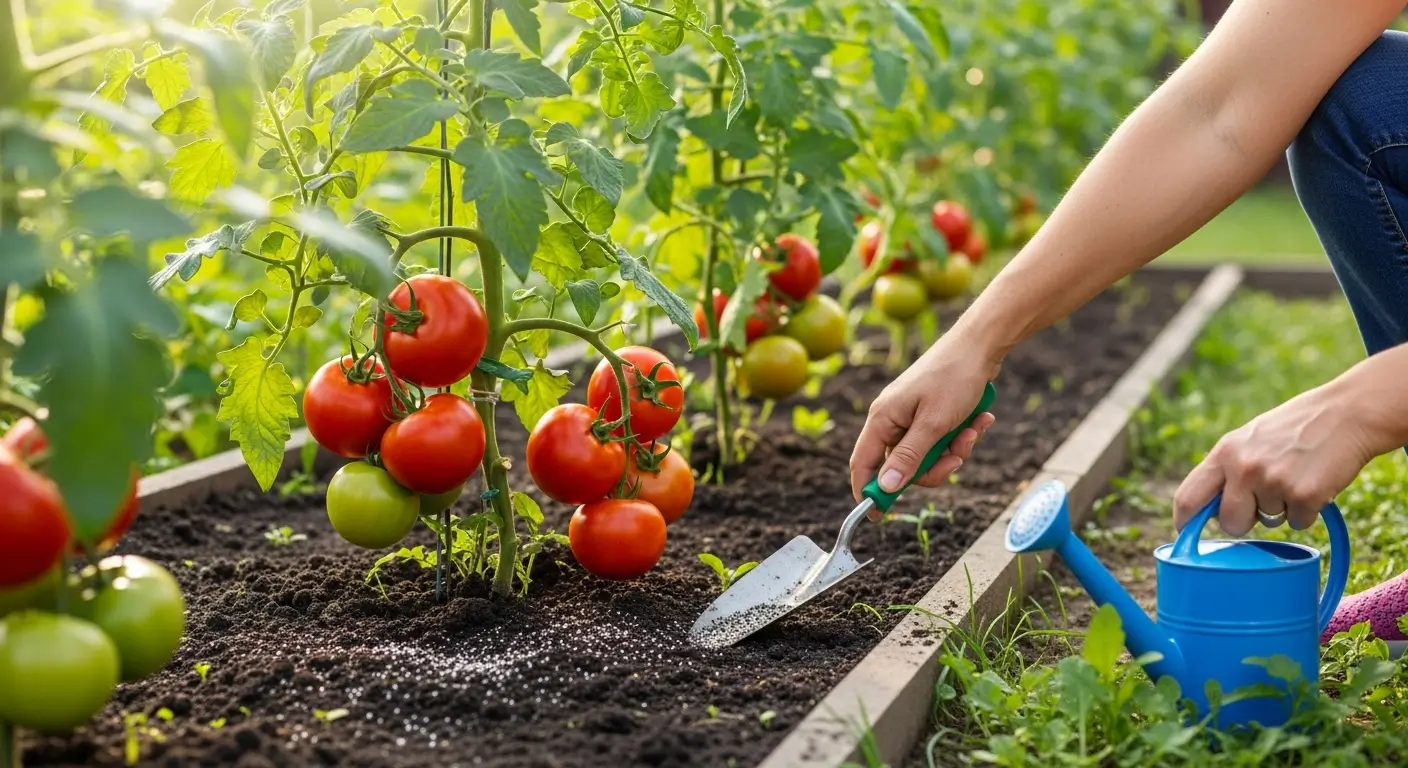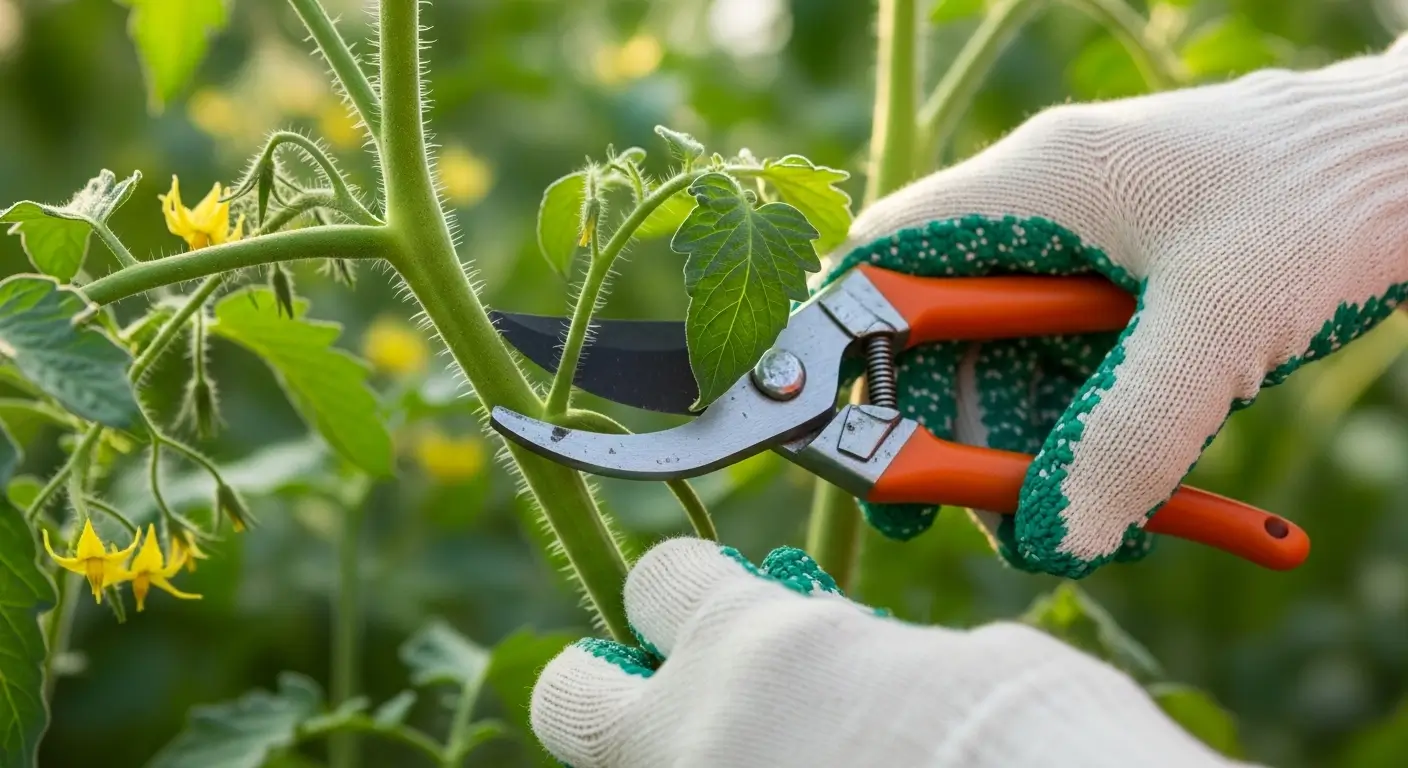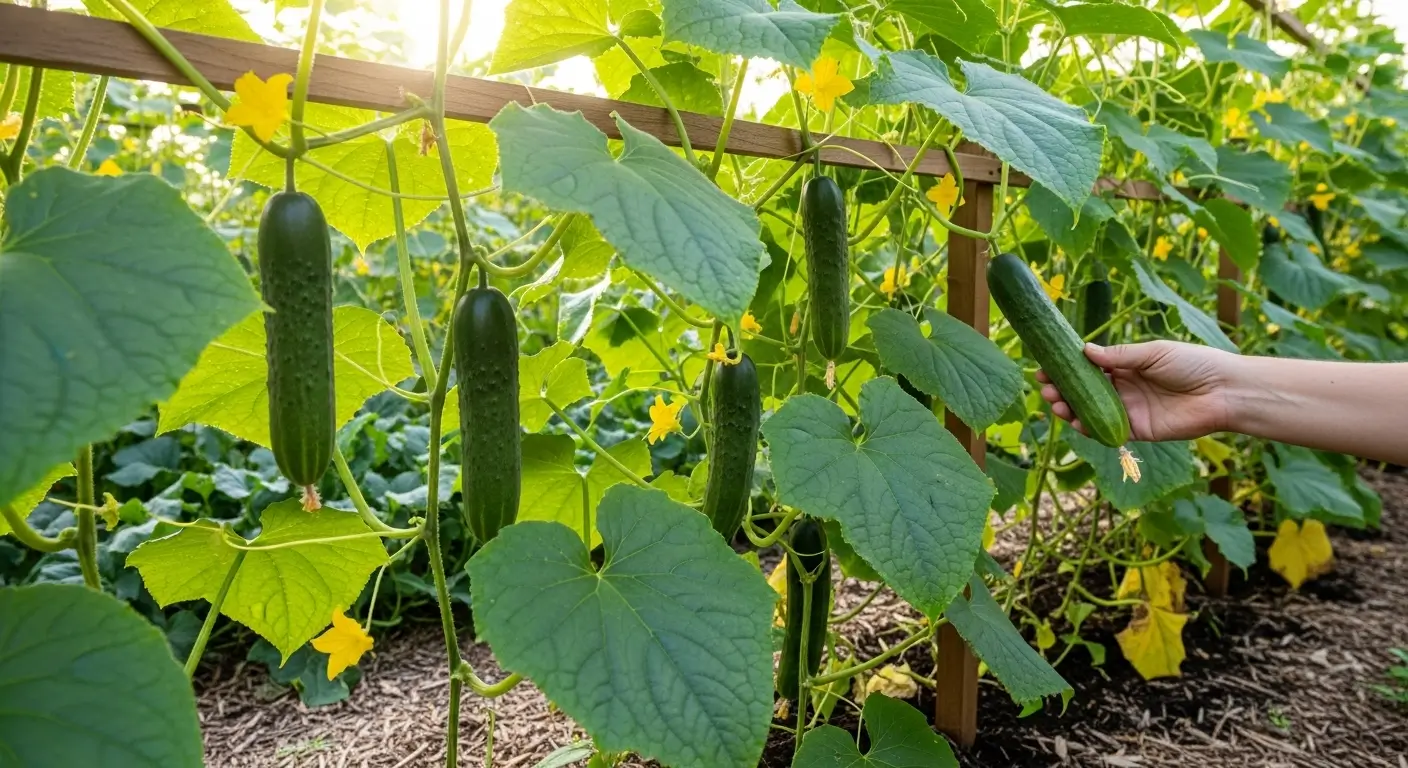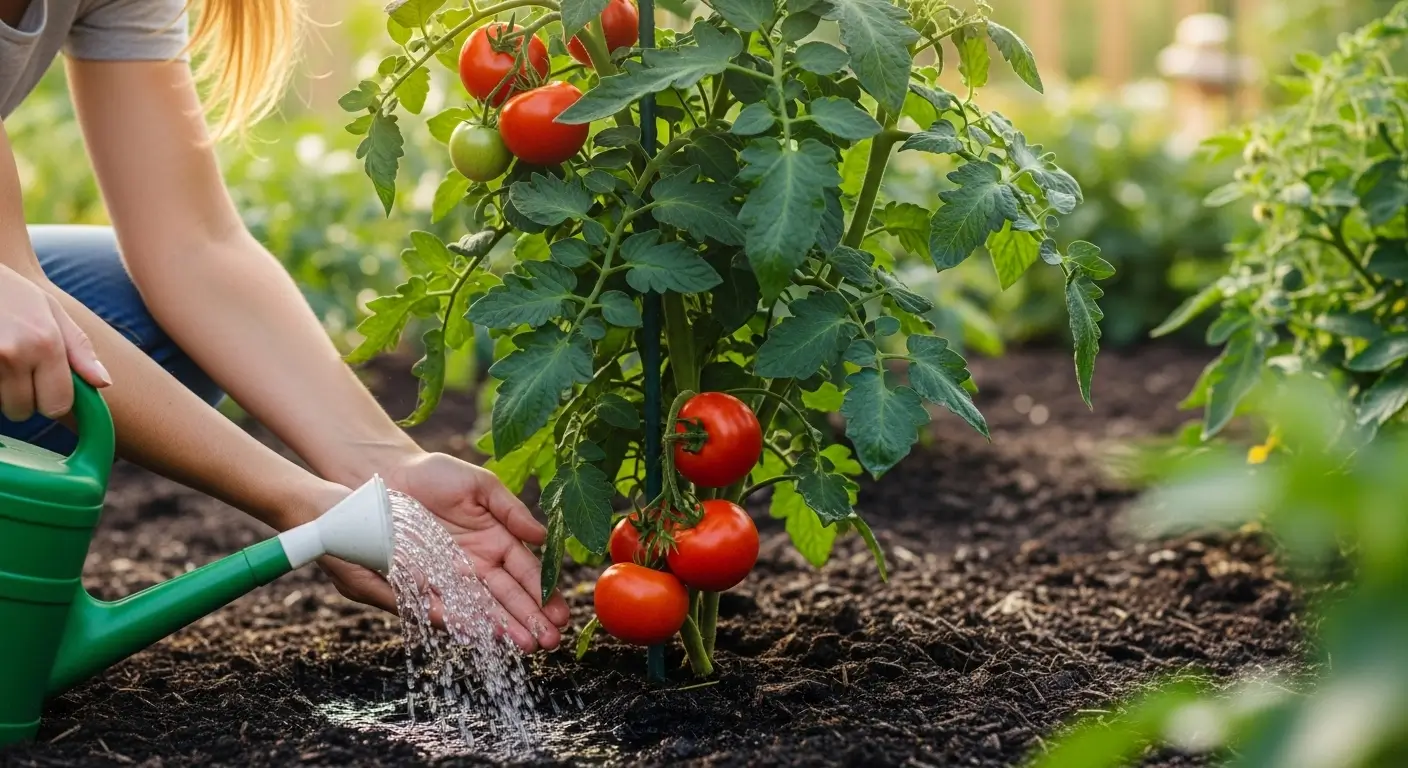Oh boy, do I have a story for you. Picture this: me, about seven years into my gardening journey, thinking I’m hot stuff because I can start seeds without killing them (which, let’s be honest, was a significant win at the time). I planted my gorgeous tomato babies in what I thought was excellent soil, watered them like my devoted plant mom, and sat back waiting for tomato magic.
What I got was a big ol’ slice of humble pie. My plants looked like they were auditioning for a sad plant commercial—tall, wimpy, and yellow from the bottom up. The harvest? Let’s say I couldn’t even make a decent BLT. Meanwhile, my neighbor’s tomatoes were basically showing off, loaded with fruit and looking like they belonged in a magazine.
It turns out that she’d been building incredible soil for years while I’d been ignoring the foundation of everything. That epic fail taught me that the best soil for tomatoes isn’t just dirt you throw plants into—it’s this amazing living thing that’s the difference between “meh” tomatoes and ones that make your neighbors secretly hate you.
After that disaster of a season, I went complete nerd on tomato soil prep, and wow, did it change everything in my garden.
Table of Contents
Why Soil Matters More Than You Think for Tomatoes
Look, I totally get why people skip the soil talk. It’s not nearly as fun as drooling over seed catalogs or planning where everything’s gonna go. But here’s the deal—tomatoes are basically the drama queens of the vegetable garden. They want what they want, and if they don’t get it, they’ll let you know by producing sad, flavorless fruit (if you’re lucky enough to get any at all).
Think of soil like the perfect mattress. You want it supportive but not rock-hard, drains well but doesn’t dry out in five minutes, and packed with all the good stuff your plants crave. Get this right, and suddenly you’ve got stronger roots, plants that can fight diseases, flowers everywhere, and tomatoes that taste like they’re supposed to. That’s because soil isn’t just dirt—it’s this amazing living ecosystem packed with billions of helpful microorganisms working 24/7 to feed your plants, something the University of Minnesota Extension’s soil health guide explains way better than I can.
I learned this the expensive way, but you don’t have to. Let me break down exactly what makes tomato soil amazing and how to create it without losing your mind.
Understanding the Perfect pH for Tomatoes
Okay, so pH testing was one of those things I kept meaning to do for years. You know how it is—you buy the test strips, they sit in your shed for three seasons, and you keep telling yourself, “next year.” When I finally got around to it, everything clicked into place.
Tomatoes are happiest when their soil pH is between 6.0 and 6.8, and slightly acidic to neutral. It’s like their comfort zone. When I tested my soil, guess what? It was hanging out at 7.5, which explained my previous failures.
Here’s the thing that blew my mind: even if your soil has all the proper nutrients, if the pH’s off, it’s like having a fully stocked kitchen but the door’s locked. Your plants can’t get to what they need. No wonder I was dealing with wimpy fruit and weird leaf issues!
Now I test every spring with those cheap little strips from the garden center (seriously, they’re like five bucks and will save you so much heartache). Once you know your pH, the question becomes: what do you actually DO with that number?
I used to stare at my test results like they were written in a foreign language. Is 7.2 bad? How much compost do I need? Should I panic if it’s 5.8? After years of trial and error (and a few soil chemistry deep dives), I created this little calculator to take the guesswork out of it.
Try this quick tool to see exactly what your soil needs:
🍅 Tomato Soil pH Calculator
Find out if your soil pH is perfect for tomatoes and get personalized recommendations
This slightly acidic range allows tomatoes to absorb nutrients most efficiently.
Recommended Actions:
- Add 2-3 inches of compost to gradually lower pH
- Work in some peat moss or pine needles
- Consider sulfur for more significant pH reduction
- Retest soil in 6-8 weeks after amendments
Pretty cool, right? It’s like having a soil expert in your back pocket. The tool gives you the same recommendations I’d give a friend, based on what I’ve learned works best for tomatoes in real gardens.
The beautiful thing about understanding your pH is that small adjustments often make huge differences. When I finally got my soil from 7.5 down to 6.4, it was like my tomatoes woke up from a long nap. Suddenly they were accessing nutrients they couldn’t touch before.
The Foundation: Creating Well-Draining, Nutrient-Rich Soil
The best soil for tomatoes needs to nail a few key things, and once I figured this out, growing tomatoes became less stressful.
Drainage is Everything
Tomatoes hate having wet feet—like, they really, REALLY hate it. I found this out when I planted some in this low spot in my yard that turned into a mini lake every time it rained. Those poor things got root rot and never recovered, while the ones I’d planted on higher ground were thriving.
Your soil should drain fast enough that puddles disappear in a few hours, but still hold enough water that you’re not out there with the hose daily. Grabbing a handful and squeezing it should feel like a sponge you’ve wrung out—moist but not soggy.
Organic Matter is Your Secret Weapon
If I could go back and shake my younger gardening self, it would be to scream, “IT’S ALL ABOUT THE COMPOST!” Seriously, organic matter is like Miracle-Grow but actually good for everything.
When I started dumping 2-3 inches of compost on my tomato beds every spring, it was like someone flipped a switch. The soil got darker and crumblier (is that a word? It is now), held water without getting swampy, and my plants just looked… happier. Stronger stems, better production, fewer drama queen moments.
My go-to additions are homemade compost, aged manure (never fresh—trust me on this one, learned that lesson the smelly way), leaf mold, and worm castings. I’m totally obsessed with mixing my own compost with store-bought worm castings for my tomatoes.
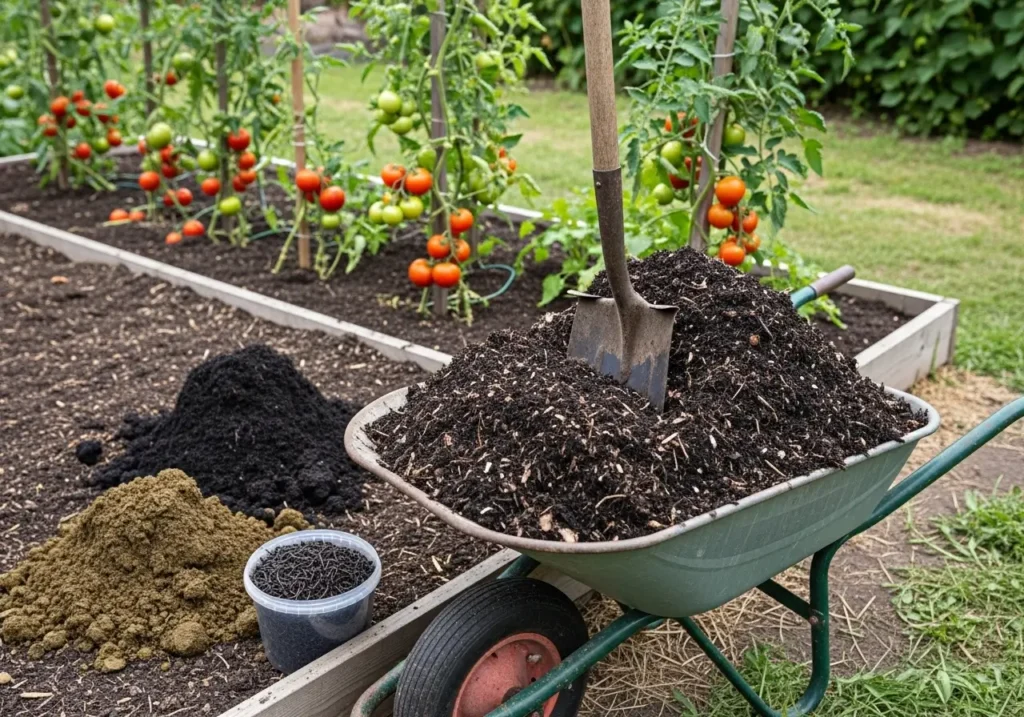
Essential Nutrients: What Tomatoes Crave Most
Understanding what tomatoes actually need has been a total game-changer. It’s like finally reading the manual instead of just pressing buttons and hoping for the best.
The Big Three: NPK
Nitrogen makes leaves grow, but here’s where I (and probably you) mess up—too much nitrogen creates these gorgeous, Instagram-worthy plants that produce about twelve tomatoes. I did this one year ago and felt so betrayed by my plants. They looked amazing but were basically just pretty decorations.
Phosphorus helps with root and fruit production. Super important when you’re getting babies established.
Potassium is like the plant’s immune system—it keeps everything healthy and helps fruit taste better.
Now I play it smart: decent nitrogen early on, then switch to the lower-nitrogen stuff once flowers start showing up.
Don’t Forget the Little Guys
Calcium is huge for preventing blossom end rot—that gross black spot that ruins delicious tomatoes. I toss crushed eggshells in my compost and work some bone meal into planting holes.
Magnesium keeps leaves from getting that weird yellow-between-the-veins look. Epsom salt works great if you need a quick fix.
Organic Soil Amendments for Tomatoes That Actually Work
I’ve tried almost every organic amendment you can buy (my credit card can confirm this), and some definitely work better than others for tomatoes. Here’s what I actually use now:
My Go-To Amendment Recipe
For each tomato plant, I mix in:
- 2-3 shovelfuls of good compost
- A handful of worm castings
- A tablespoon of bone meal
- A sprinkle of kelp meal for trace minerals
I work this right into the planting hole and the surrounding soil. It’s like making a gourmet meal for your plants from day one.
Composted Manure: The Classic That Works
Well-aged cow or horse manure is fantastic for tomatoes. Key word: AGED. Fresh manure will fry your plants and might give you some unwanted bacteria. Yeah, I learned this the hard way when I got too excited about “free” manure from a local farm.
If you’re buying bagged stuff, make sure it says “composted” or “aged.” It should look dark and crumbly, not chunky or stinky.
Coffee Grounds: The Overhyped Amendment
Everyone and their brother swears by coffee grounds, but honestly? They’re not the miracle cure people make them out to be. Used coffee grounds aren’t even acidic like everyone thinks; if you use them straight, they can repel water.
I toss mine in the compost pile instead of putting them directly on plants. There is way less drama, and they break down into something actually useful.
Preparing Your Tomato Soil: Step-by-Step Process
Here’s how I prep my tomato soil now, after years of figuring out what actually works:
Timing is Everything
I start prepping in early spring, about 4-6 weeks before our last frost date. This gives everything time to settle and get cozy before planting day.
The Process
- Test your soil pH with strips or a digital meter. Seriously, do it. It’s like $5 and will save you so much guessing.
- Clear and loosen everything down about 12 inches. I use a broadfork because it loosens without totally destroying all the good stuff happening in the soil.
- Add your good stuff generously. I spread 2-3 inches of compost over the whole bed, plus my special tomato mix in each planting spot.
- Mix it all together gently. I don’t go crazy with tilling anymore—just enough to blend everything without killing beneficial soil critters.
- Let it chill for a few weeks before planting. This lets everything mesh together and creates the perfect environment for baby tomato roots.
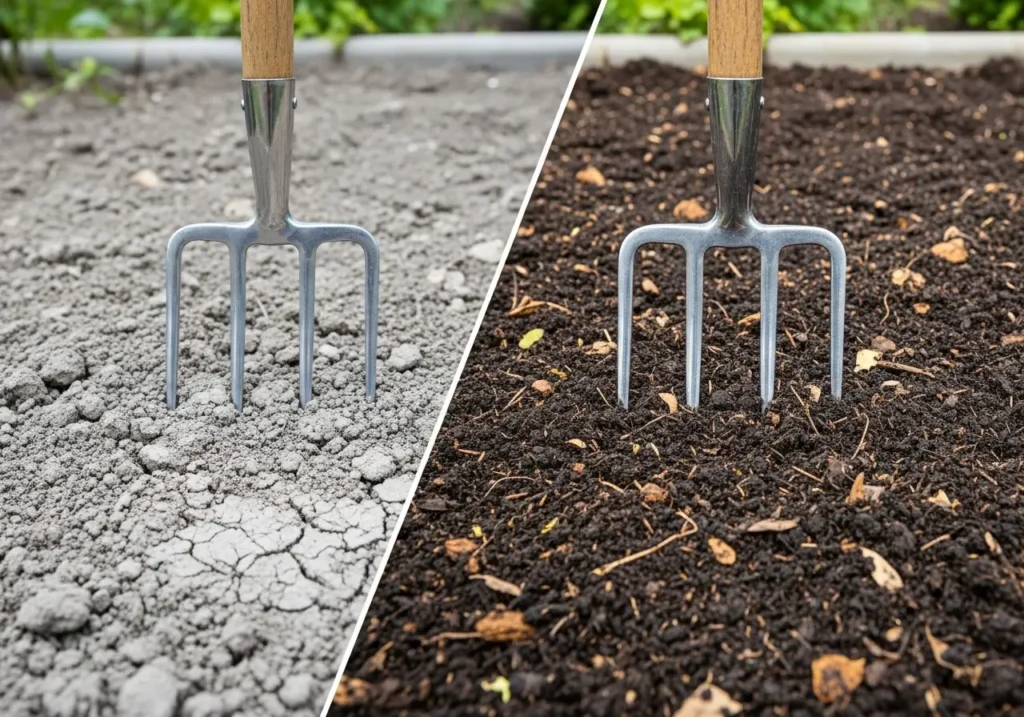
Special Considerations for Container and Raised Bed Tomatoes
If you’re doing containers or raised beds (which I absolutely love for tomatoes), you’ve got slightly different needs.
Container Growing
I start with quality potting mix for container tomatoes and jazz it up with compost and worm castings. Regular garden soil is too heavy for pots and turns into concrete when it dries out.
My container recipe:
- 60% good potting mix
- 30% compost
- 10% perlite or coarse sand for drainage
Want all the nitty-gritty details on container growing? Check out my complete guide to growing tomatoes in containers—I cover everything from picking the right pots to not drowning your plants.
Raised Bed Success
Raised beds are like having total control over your soil destiny, which is why I’m obsessed with them for tomatoes. You’re basically building the perfect soil from scratch.
I fill mine with roughly equal parts compost, aged manure, and good topsoil. The trick is getting drainage right while keeping everything fertile.
If you want to dive deep into raised bed specifics, my raised bed tomatoes complete growing guide covers soil ratios, how deep to go, and keeping everything happy.
Maintaining Soil Health Throughout the Growing Season
Making great soil is just step one—keeping it awesome all season long is what separates the pros from the rest of us.
Mulching: Your Soil’s Best Friend
I mulch around my tomatoes with 2-3 inches of organic stuff like straw, shredded leaves, or grass clippings (make sure they’re herbicide-free!). This keeps weeds away, holds in moisture, and slowly breaks down to feed the soil.
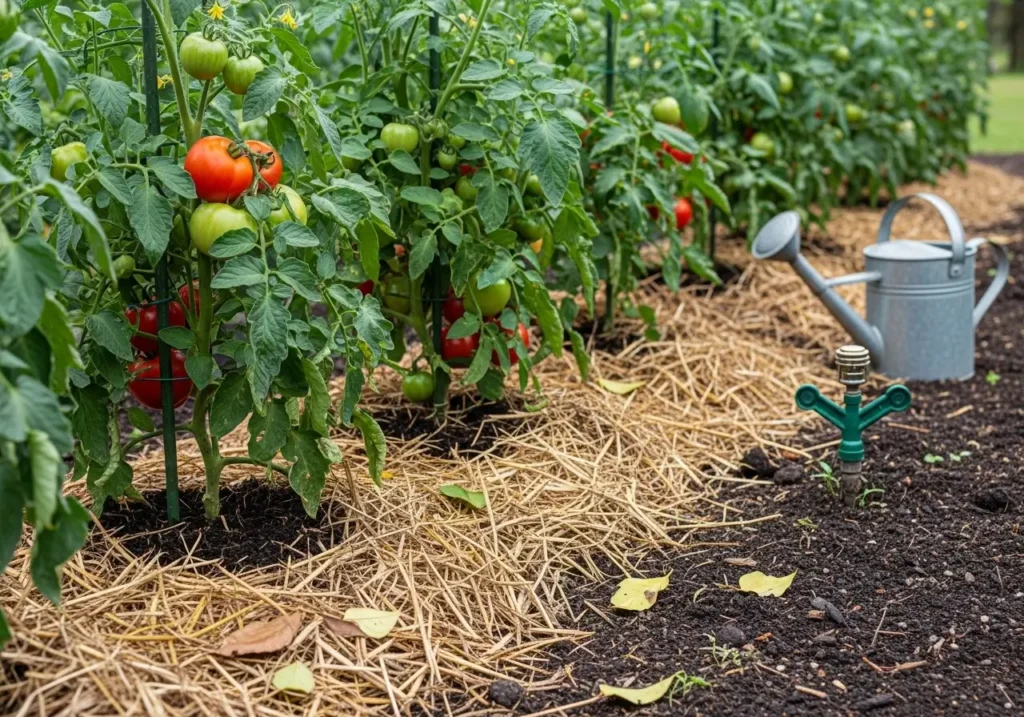
Side-Dressing for Sustained Nutrition
About a month after planting, I give my tomatoes a little snack with compost or balanced organic fertilizer. It’s like a protein shake when they hit their growth spurt.
Monitoring and Adjusting
I keep an eye on things throughout the season. Yellow bottom leaves might mean they need nitrogen, while lousy fruit set could be a phosphorus thing. The cool part about building good soil is that it gets more forgiving over time.
Common Soil Mistakes That Kill Tomato Harvests
Let me save you from the mistakes I’ve made so you don’t have to learn the hard way:
Over-Fertilizing with Nitrogen
This gives you gorgeous plants that produce maybe six tomatoes. I had a whole season like this and felt totally betrayed by my beautiful, useless plants.
Ignoring Soil Compaction
If you can’t easily stick a shovel in your soil, your tomatoes are struggling too. Compacted soil is like trying to grow plants in concrete.
Planting in the Same Spot Every Year
Tomatoes get hit by soil diseases that build up over time. I rotate locations every year now, and my plants are way healthier for it.
Skipping the pH Test
This was my biggest mistake for years. You can add all the fancy amendments you want, but if your pH’s wrong, it’s all locked up and useless.
Building Soil for Long-Term Tomato Success
The best soil for tomatoes isn’t a one-and-done deal—it’s like maintaining a friendship. You keep adding good stuff, pay attention to how things are going, and adjust when needed.
What I love most about focusing on soil is that it helps everything in your garden, not just tomatoes. All the stuff that makes tomato soil amazing also makes peppers, eggplants, and pretty much everything else happy.
This foundation work might not be as exciting as picking out heirloom varieties or designing your garden layout, but trust me—it’s what separates struggling plants from harvests that make your neighbors wonder if you’ve got some secret tomato magic.
The truth is, there’s no magic trick. It all starts underground with the soil your plants call home. Get that right, and you’re already winning at the tomato game. For the complete picture of tomato growing from start to finish, including how soil prep fits into everything else, check out my How to grow tomatoes complete guide.
Your tomatoes—and your taste buds—will totally thank you for taking the time to build the perfect foundation. Honestly, the best soil for tomatoes is soil that’s been put together with some thought, patience, and the correct info. That combo works every single time.
So what’s been your biggest soil challenge with tomatoes? Have you noticed a difference when you’ve improved your soil game? Drop a comment below—I love hearing about other people’s successes and failures because that’s how we all get better at this gardening thing together!
Frequently Asked Questions About the Best Soil for Tomatoes
What is the best soil pH for tomatoes?
The best soil pH for tomatoes is between 6.0 and 6.8, which is slightly acidic to neutral. This pH range allows tomatoes to access nutrients most efficiently. When pH is outside this range, nutrients can become locked up in the soil even if they’re present, leading to poor plant growth and fruit development.
What organic amendments should I add to create the best soil for tomatoes?
The most effective organic amendments for tomato soil include well-aged compost, composted manure, worm castings, bone meal, and kelp meal. For each tomato plant, mix in 2-3 shovelfuls of compost, a handful of worm castings, a tablespoon of bone meal, and a sprinkle of kelp meal directly into the planting hole and surrounding soil.
How do I prepare soil for tomatoes in containers vs. garden beds?
Container tomatoes need a lighter soil mix: use 60% quality potting mix, 30% compost, and 10% perlite for drainage. Garden beds should be amended with 2-3 inches of compost worked 6-8 inches deep. Both need well-draining soil that holds moisture without becoming waterlogged.
When should I prepare my tomato soil and how long does it take?
Start preparing tomato soil 4-6 weeks before your last expected frost date. This gives amendments time to integrate and settle before planting. The actual preparation takes a few hours, but the soil needs weeks to develop the right conditions for optimal tomato root growth.
